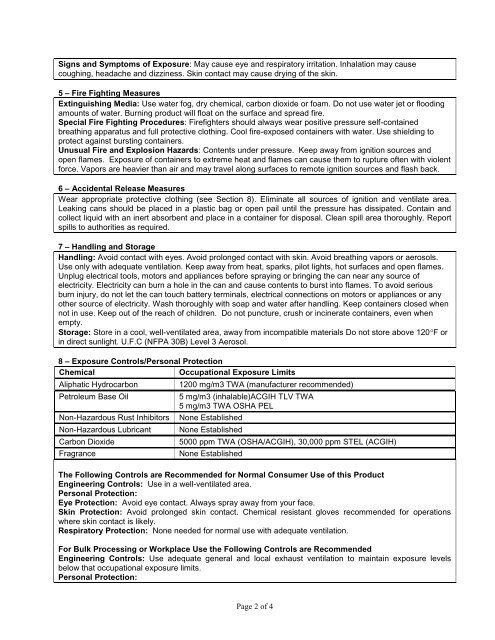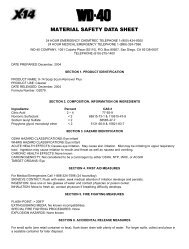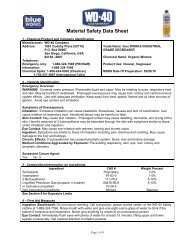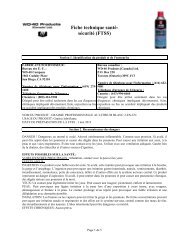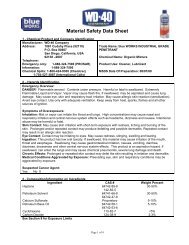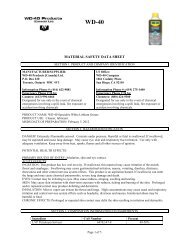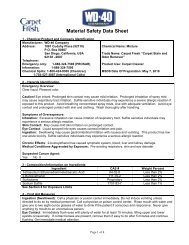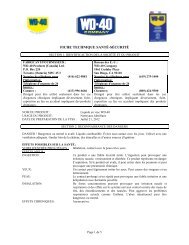Material Safety Data Sheet (MSDS) - WD-40 Company
Material Safety Data Sheet (MSDS) - WD-40 Company
Material Safety Data Sheet (MSDS) - WD-40 Company
- No tags were found...
Create successful ePaper yourself
Turn your PDF publications into a flip-book with our unique Google optimized e-Paper software.
Signs and Symptoms of Exposure: May cause eye and respiratory irritation. Inhalation may causecoughing, headache and dizziness. Skin contact may cause drying of the skin.5 – Fire Fighting MeasuresExtinguishing Media: Use water fog, dry chemical, carbon dioxide or foam. Do not use water jet or floodingamounts of water. Burning product will float on the surface and spread fire.Special Fire Fighting Procedures: Firefighters should always wear positive pressure self-containedbreathing apparatus and full protective clothing. Cool fire-exposed containers with water. Use shielding toprotect against bursting containers.Unusual Fire and Explosion Hazards: Contents under pressure. Keep away from ignition sources andopen flames. Exposure of containers to extreme heat and flames can cause them to rupture often with violentforce. Vapors are heavier than air and may travel along surfaces to remote ignition sources and flash back.6 – Accidental Release MeasuresWear appropriate protective clothing (see Section 8). Eliminate all sources of ignition and ventilate area.Leaking cans should be placed in a plastic bag or open pail until the pressure has dissipated. Contain andcollect liquid with an inert absorbent and place in a container for disposal. Clean spill area thoroughly. Reportspills to authorities as required.7 – Handling and StorageHandling: Avoid contact with eyes. Avoid prolonged contact with skin. Avoid breathing vapors or aerosols.Use only with adequate ventilation. Keep away from heat, sparks, pilot lights, hot surfaces and open flames.Unplug electrical tools, motors and appliances before spraying or bringing the can near any source ofelectricity. Electricity can burn a hole in the can and cause contents to burst into flames. To avoid seriousburn injury, do not let the can touch battery terminals, electrical connections on motors or appliances or anyother source of electricity. Wash thoroughly with soap and water after handling. Keep containers closed whennot in use. Keep out of the reach of children. Do not puncture, crush or incinerate containers, even whenempty.Storage: Store in a cool, well-ventilated area, away from incompatible materials Do not store above 120F orin direct sunlight. U.F.C (NFPA 30B) Level 3 Aerosol.8 – Exposure Controls/Personal ProtectionChemicalOccupational Exposure LimitsAliphatic HydrocarbonPetroleum Base OilNon-Hazardous Rust InhibitorsNon-Hazardous LubricantCarbon DioxideFragrance1200 mg/m3 TWA (manufacturer recommended)5 mg/m3 (inhalable)ACGIH TLV TWA5 mg/m3 TWA OSHA PELNone EstablishedNone Established5000 ppm TWA (OSHA/ACGIH), 30,000 ppm STEL (ACGIH)None EstablishedThe Following Controls are Recommended for Normal Consumer Use of this ProductEngineering Controls: Use in a well-ventilated area.Personal Protection:Eye Protection: Avoid eye contact. Always spray away from your face.Skin Protection: Avoid prolonged skin contact. Chemical resistant gloves recommended for operationswhere skin contact is likely.Respiratory Protection: None needed for normal use with adequate ventilation.For Bulk Processing or Workplace Use the Following Controls are RecommendedEngineering Controls: Use adequate general and local exhaust ventilation to maintain exposure levelsbelow that occupational exposure limits.Personal Protection:Page 2 of 4


